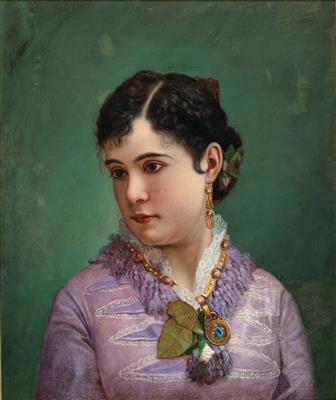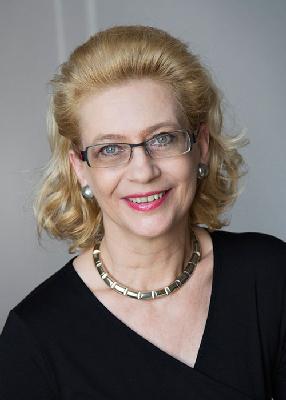Vlaho Bukovac

(Cavtat 1855–1922 Prague)
Portrait of Julia Dunphy Piercy (?) Wearing a Necklace with Old-Cut Diamonds, Aquamarine, Small Emeralds and Rubies and Gold Ear Pendants, signed, dated Fagioni Artist 1876, oil on canvas, 61 x 51 cm, framed
Provenance:
Private Collection Germany.
Compare:
Vera Kružic´ Uchytil, Vlaho Bukovac. Život i Djelo. 1855–1922, Zagreb 2005,
p. 321, no. 23.
The early years of the painter Vlaho Bukavac were marked by adventures so unusual they almost seem to come from the pages of fiction. He lived in his birthplace of Cavtat on the Dalmatian coast until the age of eleven, when his wealthy uncle took him to the far-off land of America to learn a trade. After his uncle’s sudden death, he lived with his aunt in New York. She had no interest in raising the boy and, instead of giving him an education, as promised, she put him in a home for juvenile delinquents. After this intrigue came to light, he returned to his aunt and lived in New York until 1871. He joined the Navy as a cadet and travelled to Constantinople, but he had to give up this career after suffering a serious accident, when he fell into the depths of a ship’s hold. He had already begun to draw by this time and probably inked tattoos on sailors’ arms, which was an extremely common practice among seamen. In 1873, his journey took him to Peru, where he received his first artistic commission in a factory in Callao. There, he painted figures and decorations on train carriages. It gave him little satisfaction, and finally prompted him to move to San Francisco in 1874. In San Francisco, he taught himself how to paint and received his first commissions from Isaak Lustig, a well-connected Austrian who recognised the young man’s talent for drawing and painting. As a result, he created portraits of the rich merchants who called San Francisco home. Finally, he succeeded in obtaining the financial means to return to his home country of Croatia.
With the support of the Croatian poet Medo Puci´c and Bishop Josip Juraj Strossmayer, he travelled to Paris, where he gave his name a Slavic touch, changing it from Biagio Faggioni to Vlaho Bukovac. The painter achieved great fame under this new name and completed his formal artistic training at the École des Beaux Arts from 1877 until 1880. His paintings were regularly shown at the Paris Salon and, in the 1880s, he worked for an array of patrons, including at the court of the Serbian king in Belgrade and in Dalmatia. In 1893, he settled in Zagreb, before moving to Vienna in 1902 and to Prague in 1903, where he was appointed professor at the Academy. He was a member of the Serbian Royal Academy from 1905 onwards and in 1919 he was appointed an honorary member of the Yugoslav Academy of Sciences and Arts.
This lot is an early work by Vlaho Bukovac, who at that time still bore his original name Fagioni. The portrait probably depicts Julia Dunphy Piercy, the daughter of William Dunphy, a pioneering businessman from Ireland, and his Chilean wife Carmen (see Smithsonian American Art Museum, Inventory of American Paintings, no. IAP 71065560). It is one of the seven portraits painted by Bukovac during his time in San Francisco in 1876, and had previously been considered lost. The young lady is wearing lavish jewellery, which testifies to the sitter’s middle-class background. The high level of craftsmanship of this portrait does not betray the fact that the young artist had not yet had any artistic training at this point in time, making the fine execution of the details even more impressive.
Esperta: Mag. Dimitra Reimüller
 Mag. Dimitra Reimüller
Mag. Dimitra Reimüller
+43-1-515 60-355
19c.paintings@dorotheum.at
08.06.2020 - 16:00
- Prezzo realizzato: **
-
EUR 25.300,-
- Stima:
-
EUR 20.000,- a EUR 30.000,-
Vlaho Bukovac
(Cavtat 1855–1922 Prague)
Portrait of Julia Dunphy Piercy (?) Wearing a Necklace with Old-Cut Diamonds, Aquamarine, Small Emeralds and Rubies and Gold Ear Pendants, signed, dated Fagioni Artist 1876, oil on canvas, 61 x 51 cm, framed
Provenance:
Private Collection Germany.
Compare:
Vera Kružic´ Uchytil, Vlaho Bukovac. Život i Djelo. 1855–1922, Zagreb 2005,
p. 321, no. 23.
The early years of the painter Vlaho Bukavac were marked by adventures so unusual they almost seem to come from the pages of fiction. He lived in his birthplace of Cavtat on the Dalmatian coast until the age of eleven, when his wealthy uncle took him to the far-off land of America to learn a trade. After his uncle’s sudden death, he lived with his aunt in New York. She had no interest in raising the boy and, instead of giving him an education, as promised, she put him in a home for juvenile delinquents. After this intrigue came to light, he returned to his aunt and lived in New York until 1871. He joined the Navy as a cadet and travelled to Constantinople, but he had to give up this career after suffering a serious accident, when he fell into the depths of a ship’s hold. He had already begun to draw by this time and probably inked tattoos on sailors’ arms, which was an extremely common practice among seamen. In 1873, his journey took him to Peru, where he received his first artistic commission in a factory in Callao. There, he painted figures and decorations on train carriages. It gave him little satisfaction, and finally prompted him to move to San Francisco in 1874. In San Francisco, he taught himself how to paint and received his first commissions from Isaak Lustig, a well-connected Austrian who recognised the young man’s talent for drawing and painting. As a result, he created portraits of the rich merchants who called San Francisco home. Finally, he succeeded in obtaining the financial means to return to his home country of Croatia.
With the support of the Croatian poet Medo Puci´c and Bishop Josip Juraj Strossmayer, he travelled to Paris, where he gave his name a Slavic touch, changing it from Biagio Faggioni to Vlaho Bukovac. The painter achieved great fame under this new name and completed his formal artistic training at the École des Beaux Arts from 1877 until 1880. His paintings were regularly shown at the Paris Salon and, in the 1880s, he worked for an array of patrons, including at the court of the Serbian king in Belgrade and in Dalmatia. In 1893, he settled in Zagreb, before moving to Vienna in 1902 and to Prague in 1903, where he was appointed professor at the Academy. He was a member of the Serbian Royal Academy from 1905 onwards and in 1919 he was appointed an honorary member of the Yugoslav Academy of Sciences and Arts.
This lot is an early work by Vlaho Bukovac, who at that time still bore his original name Fagioni. The portrait probably depicts Julia Dunphy Piercy, the daughter of William Dunphy, a pioneering businessman from Ireland, and his Chilean wife Carmen (see Smithsonian American Art Museum, Inventory of American Paintings, no. IAP 71065560). It is one of the seven portraits painted by Bukovac during his time in San Francisco in 1876, and had previously been considered lost. The young lady is wearing lavish jewellery, which testifies to the sitter’s middle-class background. The high level of craftsmanship of this portrait does not betray the fact that the young artist had not yet had any artistic training at this point in time, making the fine execution of the details even more impressive.
Esperta: Mag. Dimitra Reimüller
 Mag. Dimitra Reimüller
Mag. Dimitra Reimüller
+43-1-515 60-355
19c.paintings@dorotheum.at
|
Hotline dell'acquirente
lun-ven: 10.00 - 17.00
kundendienst@dorotheum.at +43 1 515 60 200 |
| Asta: | Dipinti dell’Ottocento |
| Tipo d'asta: | Asta in sala |
| Data: | 08.06.2020 - 16:00 |
| Luogo dell'asta: | Wien | Palais Dorotheum |
| Esposizione: | 27.05. - 08.06.2020 |
** Prezzo d'acquisto comprensivo di tassa di vendita e IVA
Non è più possibile effettuare un ordine di acquisto su Internet. L'asta è in preparazione o è già stata eseguita.
Altri oggetti dell'artista
-

Stima:
EUR 12.000,- a EUR 20.000,-
